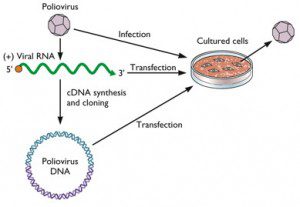

The introduction of foreign DNA into cells is called DNA-mediated transformation to distinguish it from the oncogenic transformation of cells caused by tumor viruses and other insults. The term transfection (transformation-infection) was coined to describe the production of infectious virus after transformation of cells by viral DNA, first demonstrated with bacteriophage lambda. Unfortunately, transfection is now routinely used to describe the introduction of any DNA or RNA into cells.
If you view the English language as a dynamic means of communication that continually evolves and provides words with new meanings, then this incorrect use of transfection probably does not bother you. But scientists must be precise in their use of language, otherwise their ability to communicate will be impaired. This is why the use of transfection to mean anything other than introduction of viral DNA into cells is a bad idea. I do understand that transfection is much easier to write or speak than DNA-mediated transformation, but surely that cannot be an excuse for warping a word’s meaning.
The misuse of transfection bothers me so much, that whenever I see the term, I inspect the usage to see if it is incorrect. Recently after seeing another improper use of the word, I decided to look up its roots. What I found made me reconsider my angst about transfection.
The word ‘trans’ can mean across or through. The word infection, from which the -fection in transfection is derived, comes from the Latin verb inficere: from in (into) + facere (put, do). From this analysis we can determine that transfection means across-put. That is not a bad definition of what transfection has come to mean: put DNA across a membrane into the cell.
I am certainly not a student of etymology, but it seems to me that without knowing it, those who used transfection in the wrong way were actually correct in their usage. I no longer need fret about how transfection is used!

It doesn’t bother me as much as the use of the noun virus as an adjective…
How about the use of ‘titer’ as a verb? As in: I tiered the virus stock. Should be: I determined the titer, or I titrated the infectivity.
Verbing really mads me.
As a non-English speaker, I have seen most English speakers say ‘titrated’. But most non-English speakers say ‘titered’. We must die.